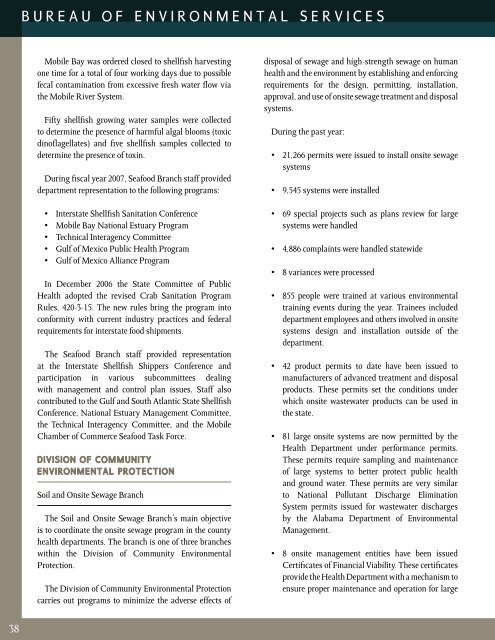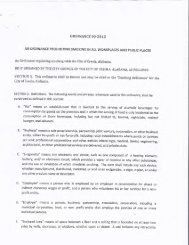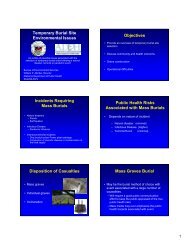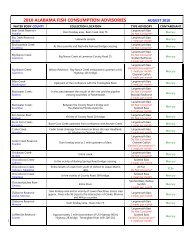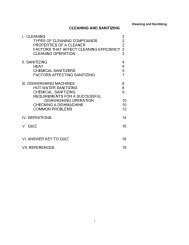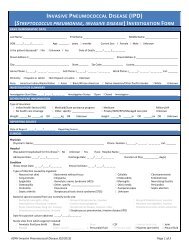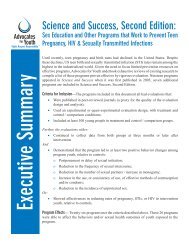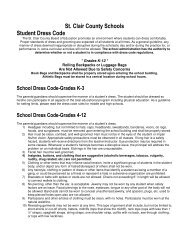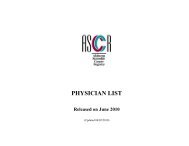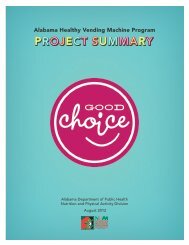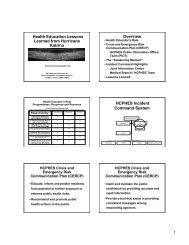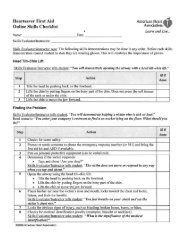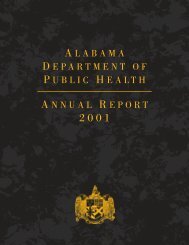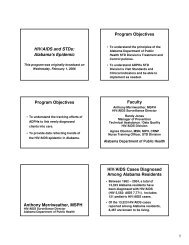2007 - Alabama Department of Public Health
2007 - Alabama Department of Public Health
2007 - Alabama Department of Public Health
You also want an ePaper? Increase the reach of your titles
YUMPU automatically turns print PDFs into web optimized ePapers that Google loves.
ureau <strong>of</strong> environmental services<br />
Mobile Bay was ordered closed to shellfish harvesting<br />
one time for a total <strong>of</strong> four working days due to possible<br />
fecal contamination from excessive fresh water flow via<br />
the Mobile River System.<br />
Fifty shellfish growing water samples were collected<br />
to determine the presence <strong>of</strong> harmful algal blooms (toxic<br />
din<strong>of</strong>lagellates) and five shellfish samples collected to<br />
determine the presence <strong>of</strong> toxin.<br />
During fiscal year <strong>2007</strong>, Seafood Branch staff provided<br />
department representation to the following programs:<br />
• Interstate Shellfish Sanitation Conference<br />
• Mobile Bay National Estuary Program<br />
• Technical Interagency Committee<br />
• Gulf <strong>of</strong> Mexico <strong>Public</strong> <strong>Health</strong> Program<br />
• Gulf <strong>of</strong> Mexico Alliance Program<br />
In December 2006 the State Committee <strong>of</strong> <strong>Public</strong><br />
<strong>Health</strong> adopted the revised Crab Sanitation Program<br />
Rules, 420-3-15. The new rules bring the program into<br />
conformity with current industry practices and federal<br />
requirements for interstate food shipments.<br />
The Seafood Branch staff provided representation<br />
at the Interstate Shellfish Shippers Conference and<br />
participation in various subcommittees dealing<br />
with management and control plan issues. Staff also<br />
contributed to the Gulf and South Atlantic State Shellfish<br />
Conference, National Estuary Management Committee,<br />
the Technical Interagency Committee, and the Mobile<br />
Chamber <strong>of</strong> Commerce Seafood Task Force.<br />
Division <strong>of</strong> Community<br />
Environmental Protection<br />
Soil and Onsite Sewage Branch<br />
The Soil and Onsite Sewage Branch’s main objective<br />
is to coordinate the onsite sewage program in the county<br />
health departments. The branch is one <strong>of</strong> three branches<br />
within the Division <strong>of</strong> Community Environmental<br />
Protection.<br />
The Division <strong>of</strong> Community Environmental Protection<br />
carries out programs to minimize the adverse effects <strong>of</strong><br />
disposal <strong>of</strong> sewage and high-strength sewage on human<br />
health and the environment by establishing and enforcing<br />
requirements for the design, permitting, installation,<br />
approval, and use <strong>of</strong> onsite sewage treatment and disposal<br />
systems.<br />
During the past year:<br />
• 21,266 permits were issued to install onsite sewage<br />
systems<br />
• 9,545 systems were installed<br />
• 69 special projects such as plans review for large<br />
systems were handled<br />
• 4,886 complaints were handled statewide<br />
• 8 variances were processed<br />
• 855 people were trained at various environmental<br />
training events during the year. Trainees included<br />
department employees and others involved in onsite<br />
systems design and installation outside <strong>of</strong> the<br />
department.<br />
• 42 product permits to date have been issued to<br />
manufacturers <strong>of</strong> advanced treatment and disposal<br />
products. These permits set the conditions under<br />
which onsite wastewater products can be used in<br />
the state.<br />
• 81 large onsite systems are now permitted by the<br />
<strong>Health</strong> <strong>Department</strong> under performance permits.<br />
These permits require sampling and maintenance<br />
<strong>of</strong> large systems to better protect public health<br />
and ground water. These permits are very similar<br />
to National Pollutant Discharge Elimination<br />
System permits issued for wastewater discharges<br />
by the <strong>Alabama</strong> <strong>Department</strong> <strong>of</strong> Environmental<br />
Management.<br />
• 8 onsite management entities have been issued<br />
Certificates <strong>of</strong> Financial Viability. These certificates<br />
provide the <strong>Health</strong> <strong>Department</strong> with a mechanism to<br />
ensure proper maintenance and operation for large<br />
38


